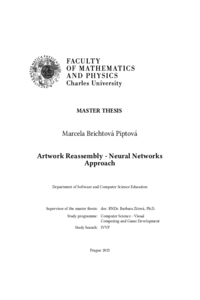Skládání uměleckých děl pomocí neuronových sítí
Artwork reassembly - neural networks approach
diploma thesis (DEFENDED)

View/
Permanent link
http://hdl.handle.net/20.500.11956/199823Identifiers
Study Information System: 282863
Collections
- Kvalifikační práce [11563]
Author
Advisor
Consultant
Karella, Tomáš
Referee
Harmanec, Adam
Faculty / Institute
Faculty of Mathematics and Physics
Discipline
Computer Science - Visual Computing and Game Development
Department
Department of Software and Computer Science Education
Date of defense
10. 6. 2025
Publisher
Univerzita Karlova, Matematicko-fyzikální fakultaLanguage
Czech
Grade
Excellent
Keywords (Czech)
restaurování obrazů|neuronové sítě|skládání puzzleKeywords (English)
artwork restoration|neural network|jigsaw assemblyTato diplomová práce představuje přístup založený na hlubokém učení k rekonstrukci fragmentovaných objektů, se zaměřením na obnovu uměleckých děl. Rekonstrukce je klíčová v oblastech, jako je archeologie nebo restaurace uměleckých děl, kde hraje zásadní roli v ochraně a studiu historických ar- tefaktů. Pro účely vývoje a testování naší metody jsme vytvořili syntetický dataset, který realisticky simuluje fragmentaci skutečných objektů, s použi- tím veřejně dostupných uměleckých děl. Tento dataset zahrnuje nepravidelné tvary, složité obrysy a různé velikosti fragmentů, které se běžně vyskytují v reálných případech. Naše metoda využívá jednorozměrnou konvoluční neuronovou síť s archi- tekturou inspirovanou U-Netem, která se zaměřuje na identifikaci podobností mezi fragmenty na základě jejich obrysů. Tyto lokální shody jsou následně propojeny pomocí algoritmu, jenž postupně seskupuje fragmenty na základě míry jejich shody a zároveň eliminuje případné nesrovnalosti. Navržený pří- stup dosahuje dobrých výsledků jak na syntetických datech, tak na reálných příkladech, což potvrzuje jeho široký potenciál pro různé rekonstrukční úkoly.
This thesis presents a deep learning-based approach to fragment recon- struction, with a focus on artwork restoration. Reconstruction is often nec- essary in fields like art conservation and archaeology, where reassembling fragmented objects aids in research and preservation. To develop and eval- uate our method, we created a synthetic dataset simulating real-world frag- mentation using publicly available artworks. The dataset captures irregular shapes, complex contours, and varying fragment sizes typical of practical reconstruction scenarios. Our method uses a 1D convolutional neural network with a U-Net-inspired architecture to identify contour-based correspondences between fragments. These local matches are then integrated through a global assembly algo- rithm, which incrementally merges clusters of pieces based on match con- fidence while addressing potential inconsistencies. The proposed approach demonstrates strong performance on both synthetic benchmarks and real- world examples, highlighting its potential across a range of reconstruction tasks.
